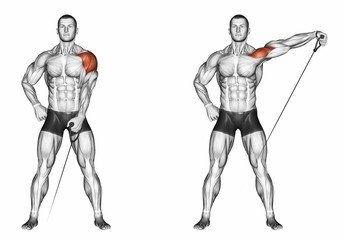Contents
The cable lateral raise primarily targets the medial deltoids, which are key for building wider, more defined shoulders. It’s between the anterior and posterior deltoids, the medial deltoid is the outer part of the shoulder, giving it that rounded, sculpted shape. Its main job? It moves your arm away from your body. (And no, this has nothing to do with the medial deltoid ligament in your foot, so no need to go googling foot anatomy here)

The only things that should be moving are your arm and shoulder. If you’re twisting or flailing to hoist that weight, you’re probably lifting too much—drop the ego and focus on the target muscle!
The cable lateral raise mimics the natural movement of the medial deltoid while adding the challenge of constant tension from the cable. This makes your shoulders stronger and more defined over time. The cable keeps your delts working throughout the full range of motion. If you’re aiming for that ‘capped’ shoulder look that turns heads at the gym, this exercise is your friend.
Start light, get the form down, and progressively increase the weight as you grow stronger. The key to mastering this move is getting a good stretch at the top and controlling the ascent and descent to maximize time under tension.
There’s a lot of debate online on which is better—cable lateral raises or dumbbell lateral raises?” The truth is, both exercises target the same muscle, the medial deltoid, but the difference lies in how each exercise delivers tension to the muscle. Let’s break it down:
With dumbbells, gravity is your main opponent. The resistance is heaviest at the top of the lift (when your arms are parallel to the ground), but as you lower the weight, gravity pulls the dumbbells straight down, meaning less tension on the delts at the bottom.
Cables, on the other hand, provide constant tension throughout the entire range of motion. Unlike dumbbells, where you lose resistance at the bottom, the cable keeps your medial delts engaged the entire time, from the start of the movement to the top.
Muscles worked with Cable Lateral Raise
It’s not a matter of “either-or,” but more of “why not both?” Dumbbells are great for beginners or those looking for a simple, effective way to work the medial deltoid. They’re a classic. But cables? They’re a game-changer when you want to really dial in that full range of motion and keep tension constant.
If you’re in a rush or don’t have access to a cable machine, grab some dumbbells and go for it. But if you’re looking to level up your shoulder training and really focus on sculpting that rounded look, cables are a fantastic option.
Workout Tip: Try alternating between the two in your workout routine. Start with cables for that constant tension, then finish with dumbbells to push your delts to fatigue. Your shoulders will be on fire—in the best way possible!